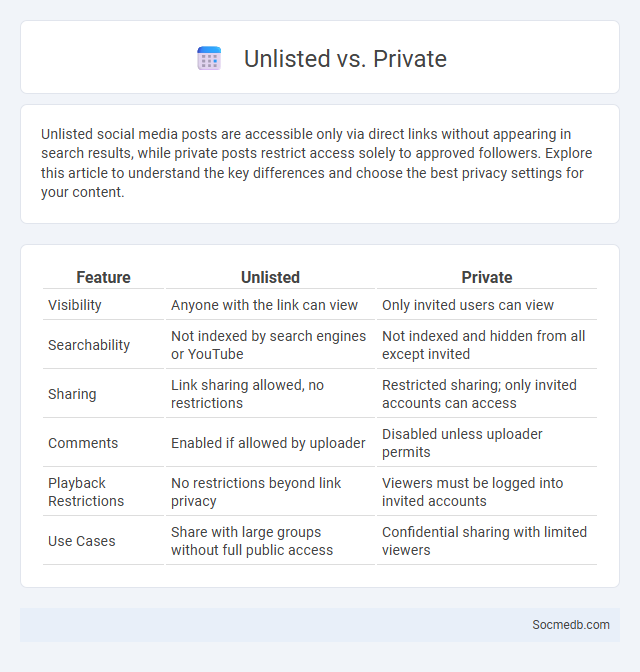
Photo illustration: Unlisted vs Private
Unlisted social media posts are accessible only via direct links without appearing in search results, while private posts restrict access solely to approved followers. Explore this article to understand the key differences and choose the best privacy settings for your content.
Table of Comparison
| Feature | Unlisted | Private |
|---|---|---|
| Visibility | Anyone with the link can view | Only invited users can view |
| Searchability | Not indexed by search engines or YouTube | Not indexed and hidden from all except invited |
| Sharing | Link sharing allowed, no restrictions | Restricted sharing; only invited accounts can access |
| Comments | Enabled if allowed by uploader | Disabled unless uploader permits |
| Playback Restrictions | No restrictions beyond link privacy | Viewers must be logged into invited accounts |
| Use Cases | Share with large groups without full public access | Confidential sharing with limited viewers |
Introduction to Video Privacy Settings
Video privacy settings on social media platforms allow users to control who can view, comment, or share their content, enhancing personal data security. Options typically include public, friends-only, private, or custom lists, enabling tailored audience targeting. Understanding and properly configuring these settings is crucial for protecting personal information and managing digital presence effectively.
What is an Unlisted Video?
An unlisted video on social media platforms is a type of content that doesn't appear in public search results, recommendations, or your channel's public playlists. Only users who have the direct link can view the video, ensuring controlled access without complete privacy restrictions. You can use unlisted videos to share sensitive or exclusive content with select individuals without making it publicly searchable or visible.
What is a Private Video?
A private video on social media is content restricted to specific viewers chosen by the uploader, ensuring only authorized individuals can access it. This privacy setting enhances your control over who sees your videos, safeguarding personal or sensitive information from public exposure. Platforms like YouTube, Instagram, and Facebook offer private video options to help you maintain confidentiality while sharing moments with select audiences.
Understanding Public vs Unlisted vs Private Videos
Social media platforms differentiate video privacy settings into public, unlisted, and private, each controlling audience access and visibility. Public videos are accessible to anyone and appear in search results and recommendations, maximizing reach and engagement. Unlisted videos are hidden from public search but can be viewed by anyone with the link, while private videos restrict access exclusively to specific users chosen by the uploader.
Key Differences: Unlisted vs Private Videos
Unlisted videos on platforms like YouTube are accessible to anyone with the direct link, providing a middle ground between public and private sharing, whereas private videos restrict access only to specific users you invite. You can share unlisted videos with a wider audience without exposing them to general searches or recommendations, but private videos enhance control by requiring recipient accounts to be logged in for playback. Understanding these key differences helps tailor your content privacy and sharing strategy to fit your social media goals.
Advantages of Unlisted Videos
Unlisted videos on social media platforms offer targeted sharing by limiting access to only those with the direct link, enhancing privacy and control over your content. These videos bypass public search algorithms, reducing unwanted exposure and helping you manage your audience effectively. You can leverage unlisted videos for exclusive content distribution, private promotions, or feedback without risking your channel's public reputation.
Advantages of Private Videos
Private videos on social media protect user privacy by restricting access to selected viewers, enhancing content control and security. They foster intimate sharing among trusted connections, encouraging authentic interactions and reducing unwanted exposure. By limiting visibility, private videos help creators maintain brand integrity and prevent misuse or unauthorized distribution.
Best Use Cases for Each Video Privacy Option
Video privacy options on social media platforms cater to varied use cases that enhance user experience and content control. Public settings maximize reach, ideal for brand awareness and viral content, while friends-only options foster intimate sharing among close connections. Private or unlisted videos grant you exclusive access, perfect for confidential messages, limited-time offers, or sensitive content distribution.
How to Change Video Privacy Settings
To change video privacy settings on platforms like YouTube, access your account's video manager or library, then select the video you want to edit. Choose the privacy option--public, unlisted, or private--depending on who you want to share the video with. Adjusting these settings ensures your content reaches the right audience and protects your privacy effectively.
Which Privacy Setting is Right for You?
Choosing the right privacy setting on social media depends on your personal preferences and the level of information you want to share. Platforms like Facebook, Instagram, and Twitter offer settings ranging from public visibility, where anyone can see your posts, to private modes restricting access to approved followers only. Regularly reviewing and adjusting these settings ensures control over your digital footprint and protects your personal data from unauthorized access.
 socmedb.com
socmedb.com